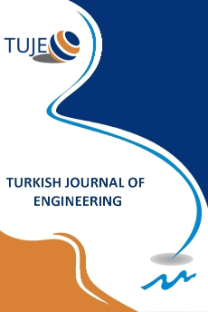MASS CONCRETE CONSTRUCTION USING SELF-COMPACTING MORTAR
MASS CONCRETE CONSTRUCTION USING SELF-COMPACTING MORTAR
___
- Abdelgader, H. S., 1996. Effect of quantity of sand on the compressive strength of two-stage concrete. Mag.Concr. Res. 48(177): 353-360
- Abdelgader, H. S., and Górski, J., 2002. Influence of grout proportions on modulus of elasticity of two-stage concrete. Mag.Concr. Res. 54(4): 251-255
- Abdelgader, H. S., and Górski, J., 2003. Stress-strain relations and modulus of elasticity of two-stage concrete. J. Mater. Civ. Eng. 15(4): 329-334
- Abdelgader, H. S., and Ben-zeitun, A. E., 2004. Effect of grout proportions on tensile strength of two-stage concrete measured by split and double-punch tests. Structural Concrete 5(4): 173-177
- Abdelgader, H. S., Ben-Zeitun, A. E., Saud, A. F. and Elgalhud, A. A., 2006. Mechanical Behavior of TwoStage (Pre-placed Aggregate) Concrete. The 10th Arab Structural Engineering Conference, Kuwait
- Abdelgader, H. S. and Elgalhud, A. A., 2008. Effect of grout proportions on strength of two-stage concrete. Structural Concrete 9(3): 163-170
- ACI Committee 116 (116R-00), 2008. Cement and Concrete Terminology Part I: ACI Manual of Concrete Practice
- ACI Committee 207 (207.1R-05), 2008. Mass Concrete Part II: ACI Manual of Concrete Practice
- ACI Committee 304 (304.1R-92), 2008. Guide for the Use of Preplaced Aggregate Concrete for Structural and Mass Concrete Applications Part II: ACI Manual of Concrete Practice
- ACI Committee 318 (ACI 318-14), 2015. Commentary on Building Code Requirements for Structural Concrete: American Concrete Institute
- Afshinnia, K., and Poursaee, A., 2015. The potential of ground clay brick to mitigate Alkali–Silica Reaction in mortar prepared with highly reactive aggregate Const. Build. Mater. 95: 164-170
- ASTM C 150, 2012. Standard specification for Portland cement, American Society of Testing and Materials, West Conshohocken, PA: ASTM International
- ASTM C 595, 2000. Standard Specification for Blended Hydraulic Cements. American Society of Testing and Materials, West Conshohocken, PA: ASTM International
- ASTM C618-15, 2015. Standard Specification for Coal Fly Ash and Raw or Calcined Natural Pozzolan for Use in Concrete, American Society of Testing and Materials, West Conshohocken, PA: ASTM International
- Akgüngör, A., Sevim, Ö., Kalkan, İ. and Demir, İ., 2018. Restrained Shrinkage Cracking of Self-Consolidating Concrete Roads. Sci. Eng. Compos. Mater. 43:112
- Baumann, P., 1948 Use of Prepacked Aggregate Concrete in Major Dam Construction. ACI Journal Proceedings, 20(3): 229-236
- Baronio, G., and Binda, L., 1997. Study of the Pozzolanicity of Some Bricks and Clays. Const. Build. Mater. 11(11): 41-46
- Davis, H. E., 1958. High-Density Concrete for Shielding Atomic Energy Plants. ACI Journal Proceedings 54(11): 965-977
- Davis, R. E., 1960. Prepakt method of concrete repair. In Journal Proceedings (Vol. 57, No. 8, pp. 155-172).
- Degryse, P., Elsen, J. and Waelkens, M., 2002. Study of Ancient Mortars from Sagalassos (Turkey) in view of Their Construction. Cem. Concr. Res. 32: 1457-1463
- Demir, İ., Sevim, Ö. and Tekin, E., 2018. The Effects of Shrinkage-reducing Admixtures Used in SelfCompacting Concrete on its Strength and Durability, Const. Build. Mater. 172: 153-165
- EN T S 197-1, 2012. Cement-Part 1: Composition, specifications and conformity criteria for common cements, Ankara: Turkish Standards Institute
- Kishar, E. A., Ahmed, D. A., Mohammed, M. R. and Noury, R., 2013. Effect of calcium chloride on the hydration characteristics of ground clay bricks cement pastes. Beni-Suef university journal of basic and applied sciences, 2(1): 20-30
- Mehta, P. K., and Monteiro, P. J. M., 2005. Concrete: Microstructure, Properties, and Materials. New York: McGraw-Hill
- Moropolou, A., Çakmak, A. S. and Lohvyn, N., 2000. Earthquake Resistant Construction Techniques and Materials on Byzantine Monuments in Kiev. Int. J. Soil Dyn. Earthquake Eng. 19: 603-615
- Nowek, A., Kaszubski, P., Abdelgader, H. S. and Górski, J., 2007. Effect of admixtures on fresh grout and twostage (Pre-placed aggregate) concrete. Structural Concrete 8(1): 17-23
- Rajabi, A. M. and Moaf, F. O., 2017. Simple empirical formula to estimate the main geomechanical parameters of preplaced aggregate concrete and conventional concrete. Constr. Build. Mater. 146: 485-492
- Turanlı, L., Bektaş, F. and Monteiro, P. J. M., 2003. Use of Ground Clay Brick as a Pozzolanic Material to Reduce the Alkali-Silica Reaction. Cem. Concr. Res. 33: 1539- 1542
- Waterways Experiment Station (U.S.)., 1954. Investigation of the Suitability of Prepakt Concrete for Mass and Reinforced Concrete Structures: Appendices A and B, report. Vicksburg, Mississippi. (digital.library.unt.edu/ark:/67531/metadc853010/: accessed September 20, 2018), University of North Texas Libraries, Digital Library, digital.library.unt.edu; crediting UNT Libraries Government Documents Department.
- ISSN: 2587-1366
- Yayın Aralığı: 4
- Başlangıç: 2017
- Yayıncı: Mersin Uüniversitesi
MECHANICAL AND WEAR CHARACTERISATION OF QUARRY TAILINGS REINFORCED A6063 METAL MATRIX COMPOSITES
Stephen Durowaye, Olatunde Sekunowo, Babatunde Bolasodun, Isaac Oduaran, Ganiyu Lawal
MASS CONCRETE CONSTRUCTION USING SELF-COMPACTING MORTAR
İ. Raci Bayer, Lutfullah Turanli, P. Kumar Mehta
MODELLING AND OPTIMIZATION OF THE EXAM INVIGILATOR ASSIGNMENT PROBLEM BASED ON PREFERENCES
DETERMINATION OF MALIGNANT MELANOMA BY ANALYSIS OF VARIATION VALUES
Veysel Alcan, Ahmet Kürşat Esim, Hilal Kaya
Stephen DUROWAYE, Olatunde SEKUNOWO, Babatunde BOLASODUN, Isaac ODUARAN, Ganiyu LAWAL
USER-ORIENTED FILE RESTORATION FOR OPERATING SYSTEMS
İ. Raci BAYER, Lutfullah TURANLİ, P. Kumar MEHTA
PREDICTINGTHE ENERGY PRODUCTIONOF A ROOFTOP PV PLANT BY USING DIFFERENTIAL EVOLUTION ALGORITHM
